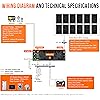







Ready to go? Add this product to your cart and select a plan during checkout. Payment plans are offered through our trusted finance partners Klarna, PayTomorrow, Affirm, Afterpay, Apple Pay, and PayPal. No-credit-needed leasing options through Acima may also be available at checkout.
Learn more about financing & leasing here.
This item is eligible for return within 30 days of receipt
To qualify for a full refund, items must be returned in their original, unused condition. If an item is returned in a used, damaged, or materially different state, you may be granted a partial refund.
To initiate a return, please visit our Returns Center.
View our full returns policy here.
Color: 3000W 24V
Features
Brand: Temank
Power Source: 110v,Battery Powered
Wattage: 3000 watts
Color: 3000W 24V
Item Dimensions LxWxH: 14.88 x 0.01 x 4.06 inches
Product Dimensions : 14.88 x 0.01 x 4.06 inches; 15 Pounds
Item model number : HF2430U60
Date First Available : December 21, 2020
Manufacturer : Temank
Customer Reviews: 3.9 3.9 out of 5 stars 146 ratings
Item Weight: 15 pounds
Product Dimensions: 14.88 x 0.01 x 4.06 inches
Item model number: HF2430U60
Warranty: 1
Date First Available: December 21, 2020


